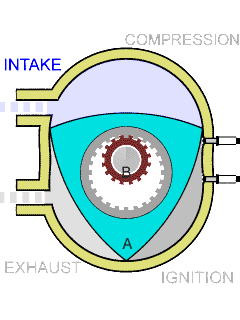Wankel engine
The Wankel engine is a type of combustion engine. It is sometimes called a rotary engine. The Wankel engine is better than an engine of the reciprocating piston design because it is more compact and simple. However, so far, nobody has found a good enough solution to the fact that oil (lubricant) has to be burnt along with the fuel. This causes pollution issues, besides wasting oil. This is why most vehicles still use piston engines.
History
The Wankel engine was first thought of by German engineer Felix Wankel in 1929. He started working on it in the early 1950s along with German car company NSU. Since, it has been used by various other car companies, but mostly in prototype cars. One exception was Mazda, which made several cars that used Wankel engines, with the most well known one being the Mazda RX-7. As of 2021, there are no cars in production that have Wankel engines.
Way it works
The Wankel engine works in a way similar to that of a regular four-stroke engine but instead of a piston going up and down, a triangle-shaped metal rotor revolves around the rod that connects to the wheels. Unfortunately, the way it works causes it to burn oil (lubricant), and this causes emissions to increase, which is why no cars use this kind of engine nowadays.
+{{{1}}}−{{{2}}}
Wankel Engine Media
Wankel diagram: Template:Ordered list*
Wankel cycle:Template:Ordered list*
Video of a two rotor Wankel engine
Chamber pressure, instantaneous unitary torque, instantaneous and average total torque plotted against shaft rotation angle. Instantaneous and average total power plotted against time. Each engine produces an average total power of 76.3 kW at pmi = 11.1 bar and pme = 8.88 bar.
Mazda RX-8 Hydrogen RE hydrogen-fuelled Wankel-engined car









